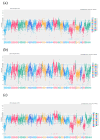Molecular Analysis of High-Grade Serous Ovarian Carcinoma Exhibiting Low-Grade Serous Carcinoma and Serous Borderline Tumor
- PMID: 39329907
- PMCID: PMC11430742
- DOI: 10.3390/cimb46090555
Molecular Analysis of High-Grade Serous Ovarian Carcinoma Exhibiting Low-Grade Serous Carcinoma and Serous Borderline Tumor
Abstract
Ovarian cancer is classified as type 1 or 2, representing low- and high-grade serous carcinoma (LGSC and HGSC), respectively. LGSC arises from serous borderline tumor (SBT) in a stepwise manner, while HGSC develops from serous tubal intraepithelial carcinoma (STIC). Rarely, HGSC develops from SBT and LGSC. Herein, we describe the case of a patient with HGSC who presented with SBT and LGSC, and in whom we analyzed the molecular mechanisms of carcinogenesis. We performed primary debulking surgery, resulting in a suboptimal simple total hysterectomy and bilateral salpingo-oophorectomy due to strong adhesions. The diagnosis was stage IIIC HGSC, pT3bcN0cM0, but the tumor contained SBT and LGSC lesions. After surgery, TC (Paclitaxel + Carbopratin) + bevacizumab therapy was administered as adjuvant chemotherapy followed by bevacizumab as maintenance therapy. The tumor was chemo-resistant and caused ileus, and bevacizumab therapy was conducted only twice. Next-Generation Sequencing revealed KRAS (p.G12V) and NF2 (p.W184*) mutations in all lesions. Interestingly, the TP53 mutation was not detected in every lesion, and immunohistochemistry showed those lesions with wild-type p53. MDM2 was amplified in the HGSC lesions. DNA methylation analysis did not show differentially methylated regions. This case suggests that SBT and LGSC may transform into HGSC via p53 dysfunction due to MDM2 amplification.
Keywords: MDM2; high-grade serous carcinoma; low-grade serous carcinoma; ovarian cancer; serous borderline tumor.
Conflict of interest statement
The authors declare no conflicts of interest.
Figures



Similar articles
-
Characterization of TP53-wildtype tubo-ovarian high-grade serous carcinomas: rare exceptions to the binary classification of ovarian serous carcinoma.Mod Pathol. 2021 Feb;34(2):490-501. doi: 10.1038/s41379-020-00648-y. Epub 2020 Aug 15. Mod Pathol. 2021. PMID: 32801341 Free PMC article.
-
Ovarian Low-grade Serous Carcinoma: A Clinicopathologic Study of 33 Cases With Primary Surgery Performed at a Single Institution.Am J Surg Pathol. 2016 May;40(5):627-35. doi: 10.1097/PAS.0000000000000615. Am J Surg Pathol. 2016. PMID: 26900814
-
Combination of TP53 and AGR3 to distinguish ovarian high-grade serous carcinoma from low-grade serous carcinoma.Int J Oncol. 2018 Jun;52(6):2041-2050. doi: 10.3892/ijo.2018.4360. Epub 2018 Apr 4. Int J Oncol. 2018. PMID: 29620196
-
Cell Origins of High-Grade Serous Ovarian Cancer.Cancers (Basel). 2018 Nov 12;10(11):433. doi: 10.3390/cancers10110433. Cancers (Basel). 2018. PMID: 30424539 Free PMC article. Review.
-
[Serous ovarian tumors].Pathologe. 2014 Jul;35(4):314-21. doi: 10.1007/s00292-014-1906-2. Pathologe. 2014. PMID: 24916775 Review. German.
Cited by
-
Exploring the Genetic and Clinical Landscape of Dedifferentiated Endometrioid Carcinoma.Int J Mol Sci. 2025 Apr 27;26(9):4137. doi: 10.3390/ijms26094137. Int J Mol Sci. 2025. PMID: 40362376 Free PMC article.
-
A Comparison of the Flow Cytometric Analysis Results of Benign and Malignant Serous Tumors of the Ovary.Cancers (Basel). 2025 Aug 19;17(16):2691. doi: 10.3390/cancers17162691. Cancers (Basel). 2025. PMID: 40867320 Free PMC article.
References
-
- Cancer Statistics Cancer Information Service, National Cancer Center, Japan (National Cancer Registry, Ministry of Health, Labour and Welfare) [(accessed on 6 October 2022)]. Available online: https://ganjoho.jp/reg_stat/statistics/data/dl/en.html.
-
- Nagase S. Patient Annual Report for 2022. Acta Obstet. Gynaecol. Jpn. 2022;74:2345–2402.
-
- Kurman R.J., Carcangiu M.L., Young R.H., Herrington C.S., editors. World Health Organization Classification of Tumours. 4th ed. International Agency for Research on Cancer; Lyon, France: 2014. WHO Classification of Tumours of Female Reproductive Organs.
Grants and funding
LinkOut - more resources
Full Text Sources
Research Materials
Miscellaneous

